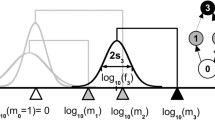Abstract
The length of the food chain has been considered to be a key characteristic of food webs, and therefore understanding its determinants is becoming increasingly important for ecosystem management and the conservation of biodiversity. For this purpose, we propose an evolutionary network model of food webs that captures the essential features of the ones in the real world. The results show some universal features of food webs, including the fractions of top, intermediate, and basal species in the webs, which are in good agreement with empirical data. We will discuss how this structure can emerge in a simple evolutionary model of food webs.
Similar content being viewed by others
References
Amaral LAN, Meyer M (1999) Environmental changes, coextinction, and patterns in the fossil record. Phys Rev Lett 82(3):652–655
Ochiai H, Suzuki R, Arita T (2009) The effects of the trophic level on the stability of food webs. Artif Life Robotics 14(3):374–383
Begon M, Harper JL, Townsend CR (1996) Ecology: individuals, populations and communities, 3rd edn. Blackwell Scientific, Oxford
Matsuno K, Ono N (1996) How many trophic levels are there? J Theor Biol 180:105–109
Pimm SL, Lawton JH (1977) Number of trophic levels in ecological communities. Nature 268:329–331
Post DM, Pace ML, Hairston NG (2000) Ecosystem size determines food-chain length in lakes. Nature 405(6790):1047–1049
Kondoh M, Ninomiya K (2009) Food-chain length and adaptive foraging. Proc R Soc B: Biol Sci 276(1670):3113–3121
Ochiai H, Suzuki R, Arita T (2011) A constructive model for the evolution of food web structure based on the trophic constraint (in Japanese). Jpn Soc Software Sci Technol 28(1):34–42
Lassig M, Bastolla U, Manrubia SC, et al (2001) Shape of ecological networks. Phys Rev Lett 86:4418–4421
Newman MEJ, Sibani P (1999) Extinction, diversity and survivorship of taxa in the fossil record. Proc Biol Sci 266:1593–1599
Pekalski A, Szwabinski J, Bena I, et al (2008) Extinction risk and structure of a food web model. Phys Rev E 77:031917 (8 pp)
Cohen JE (1978) Food webs and niche space. Princeton University Press, Princeton
Author information
Authors and Affiliations
Corresponding author
About this article
Cite this article
Ochiai, H., Suzuki, R. & Arita, T. Self-organizing stability of the food web that emerges from the evolution of restrictions on speciation. Artif Life Robotics 16, 523–525 (2012). https://doi.org/10.1007/s10015-011-0979-8
Received:
Accepted:
Published:
Issue Date:
DOI: https://doi.org/10.1007/s10015-011-0979-8




